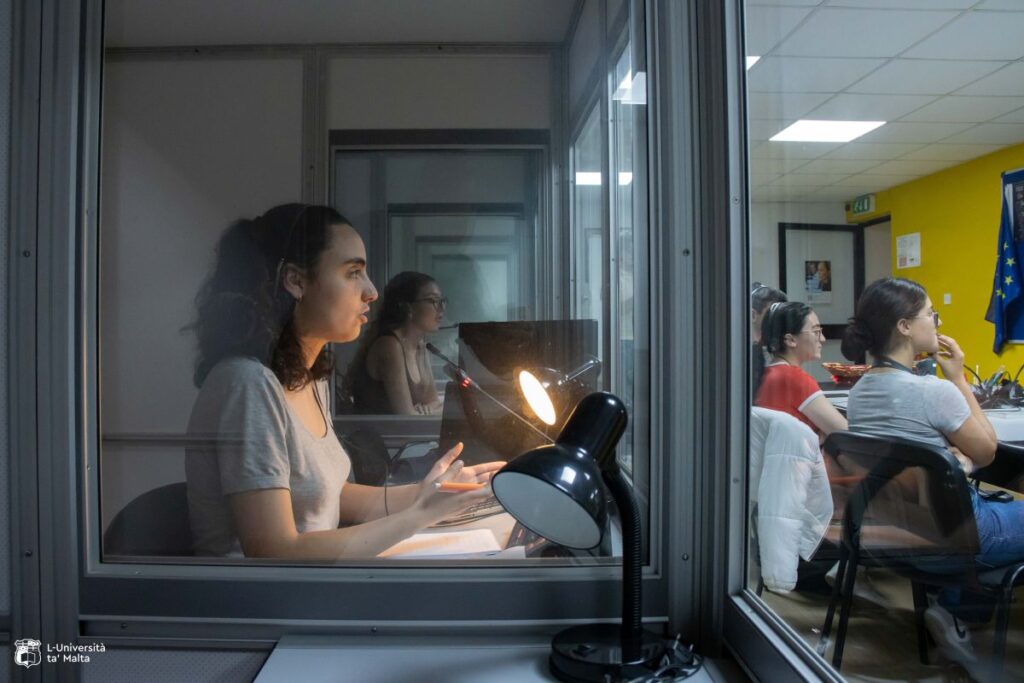“Studying interpreting at UM already offered students the opportunity to pursue a career within key international institutions – notably the European Union,” explains Dr Amy Colman (Coordinator of the Interpreting Programme within the Department of Translation, Terminology and Interpreting Studies), whose warmth and enthusiasm make one feel immediately welcome at the Interpreters’ Lab. However, the installation of new, state-of-the-art interpreting equipment offers prospective students a leap forward in what a degree in Interpreting Studies can offer.
The interpreter’s tools
Colman explains that the two main modes of interpretation are simultaneous and consecutive. In consecutive interpretation, a speech is delivered, students take notes, and afterwards render it into the target language. Learning consecutive interpretation primes one to then learn the simultaneous technique. Simultaneous interpretation is carried out live using interpreting equipment. Both methods may be used in institutional conferences and events.
In the European institutions, interpretation is a team effort, with three interpreters sharing a booth, taking turns and helping one another – given that, cognitively, it is thought to be the most stressful job after air traffic control. The interpreters in the booth write down ‘problem triggers’, such as numbers and names, which can be easy to miss or forget. They also share live tools, such as computer-assisted interpreting tools that store glossaries.
The equipment utilised by interpreters, like that found in the Interpreters’ Lab, includes interpreter desks, headsets, monitors, delegate desks, and receivers akin to remote controls paired with headphones. The audience can use these receivers to change channels and listen to their preferred language. Usually, conference interpreters work into their A language, which is their strongest language – but not necessarily their mother tongue. They can also work into their B language, which they will have mastered to a near-native level. C languages are passive languages: the interpreters understand them perfectly and can work from these languages into their A language. They never interpret into their C languages.
The language profiles in the European Union differ from one booth to the next, depending on the needs of each language unit. For the Maltese language unit, the current profiles are AB, where the interpreters work both from and into the A and B languages, and ACC, where the interpreters work solely into their A language – in this case, Maltese – from two passive languages. UM students are trained in accordance with the language profiles required by the Maltese language unit (currently AB or ACC).
Students are also trained in relay interpreting. Colman explains: ‘One does not need to have an interpreter in the booth for each official language of the European Union – and, of course, you cannot possibly cover the 24 official languages in a single booth. So, if, for example, a Bulgarian delegate is speaking, and none of the Maltese interpreters can work directly from Bulgarian into Maltese, they need to tap into a booth where Bulgarian is interpreted into a pivot language – usually, but not necessarily, English. The speech is interpreted into English, and the Maltese interpreters then render it into Maltese. That is called relay interpreting.’
Interpreting in practice
Students training in the booths either hear live mock speeches in the Lab or utilise videos from a database of speeches curated by the European Commission, which prepares them for the interinstitutional accreditation test. Colman explains that this year, the Master programme was entirely redesigned and now even includes new study-units offering experiences such as mock debates, mimicking a real-life setting.
One of the first things a student learns in an interpreting booth is that the colours on the interpreter desk are inverted. Red does not mean that the interpreter is muted; it means that the microphone is on. Green, on the other hand, means that the microphone is off – a little counter-intuitive, perhaps. There is also a convenient mute button, which is preferred, as its usage filters out acoustic shocks caused by potential volume differences between the floor and the booth.
Following the upgrade of equipment at the Interpreters’ Lab, four of the original desks have been relocated to the Aula Magna at the Valletta Campus. They now form part of a package of services offered on site and allow students to practise during events and conferences.
Moving forward, Colman is energised by the growth of interpreting at the University of Malta, as well as the resources and support it is receiving. The interpreting booths will soon host many more narratives, speeches, and stories, as they train students for a career at the heart of the European institutions.
The new interpreting equipment was installed at the Interpreters’ Lab thanks to financial support from DG LINC, the Directorate-General for Logistics and Interpretation for Conferences of the European Parliament, and DG SCIC, the Directorate-General for Interpretation of the European Commission.
For more information about the Master in Interpreting Studies, or to book a visit to the Interpreters’ Lab, do not hesitate to contact Dr Amy Colman at amy.colman@um.edu.mt
This article by Timothy Alden features in Issue 47: Disciplines of THINK Magazine, the official research magazine of the University of Malta. For more articles from the edition, pick up a copy on Campus or read here. (Republished courtesy of THINK).
